Click image for BBB rating
See our Privacy Policy
cool="cool" width="784" height="9891" border="0" cellpadding="0" cellspacing="0" gridx="16" showgridx="showgridx" usegridx="usegridx" gridy="16" showgridy="showgridy" usegridy="usegridy" bgcolor="#99ccff">
|
|
|
 |
|
|
|
|
|
|
Welcome to Spaightwood Galleries, Inc.
120 Main Street, Upton MA 01568-6193
You can follow us on Facebook and Twitter!
We blog regularly on Facebook and announce special events and special sales on both sites.
Old Master Prints: Albrecht Durer (Nuremburg, 1471-1528), The Small Woodcut Passion III
|
|
|
|
|
|
|
According to Walter Strauss (Albrecht Durer Woodcuts and Wood Blocks [NY: Abaris Books, 1980], p. 342 and after), Durer may have begun the the Small Woodcut Passion as early as 1502 or 1503, though most of the woodcuts proabably date to 1508-1510. It was completed in 1510 and published it in 1511 with Latin verses by Benedictus Chelidonius facing each plate. Some trial proofs before the first edition exist and impressions were printed from Dürer's original woodblocks up until 1612, when an Italian edition was printed from Dürer's original woodblocks. There are thirty-seven woodcuts in the series, beginning The Fall of Man and concluding with The Last Judgment. While only a few of the plates are dated, those that are suggest that Durer originally began with Christ's Entry into Jerusalem on Palm Sunday and concluded with The Last Judgment. As he was completing the series c. 1510, however, he added The Fall of Man, The Expulsion from Eden (dated 1510), The Annunciation, The Nativity, and Saints Peter, Paul, and Veronica holding the Suderium (dated 1510). These additions change the focus from a history of The Passion to a history of mankind with Adam and Eve as the source of man's woes and Jesus as man's salvation. Of all of Durer's great works in series, the Small Woodcut Passion is by far the largest. It was also one of his most popular: it was reprinted several times up to an Italian edition of 1612. Although there exist later impressions printed from Durer's original blocks, they are gray and blotchy and do not print well. In addition to the prints made from Durer's woodblocks and the copies by Marantonio Raimondi (engravings published in Venice in the early 16th century), Virgil Solis (published in Nurenberg in the late 16th century with Solis' monogram VS, and a set of very deceptive copies by Mommard published a bit later, there exists as well a set made in the 19th century from metal plates made from plaster casts of thirty-five of Durer's original woodblocks after they were given to the British Museum in 1839. In 1844 Henry Cole of the South Kensington Museum (now the Victoria and Albert Museum) published his edition of the the Durer Small Passion woodcuts and described the process by which they were made:
"The present work, with the exception of two subjects, is taken from the original engravings drawn by Albrecht Durer himself on the wood, and engraved under his own superintendence. [The consensus is that Durer cut the blocks himself for his early works including The Ship of Fools until he could train professional woodcutters to reach the level he had achieved, worlds beyond anything anyone had done up to that time in terms of subtlety, fineness of line, density, etc.] . . . [T]he present, it is believed makes the fourth edition of the genuine blocks. I say genuine blocks, for so great was the popularity and estimation of the work, that there has been more than one obvious imitation of them, besides several avowed copies constantly circulating throughout Europe. The Small Passion is stated by all writers on the subject . . . to have originally consisted of thirty-seven subjects. . . . [He then distinguishes two lifetime editions of the complete work, as opposed to individual printings of individual works that Durer sold or gave away when he traveled]. The third edition of the genuine woodcuts was published at Venice, in 1612, by a Librarian who, according to Heinecke, purchased them in the Netherlands. . . . The engravings republished in the present volumes are from the same blocks. Thirty-five of the thirty-seven of them have found a secure resting place in the British Museum. They were purchased in 1839 by Mr. Josi, the present keeper of the prints, from the Rev. P. E. Boissier, whose father bought them many years ago in Italy. . . . The four impressions of these blocks which were printed by Mr. Otley in his History of Engraving, (p. 730) show the extent of the damage which the blocks have suffered. But in the present edition of them, the defects have been remedied by using stereotype casts of the blocks, which have been taken by a special permission of the trustees of the British Museum [that would never have happened in this century!]. New border lines have been added, the worm-holes stopped, and those parts skillfully recut by Mr. Thurston Thompson, who has also re-engraved with full feeling, the subjects of the Sitting Christ and of Jesus Parting from his Mother. The process of stereotyping has had the good effect of restoring almost the original sharpness and crispness of the lines, and of rendering the present impressions nearer the state of the earliest impressions than they would have been had they been taken from the blocks themselves. This statement may seem paradoxical, but it will be seen that it has a reasonable explanation. In order to take a metal cast of a woodcut, a cast is first taken in moist plaster of Paris. This is thoroughly dried by baking, which causes it to shrink throughout, sometimes as much as the eighth of an inch in a cast of six inches in length. The result of this slight shrinkage has been to reduce these thickened lines nearly to their original fineness, and several of the present impressions are so crisp and clear that they will not suffer by comparison with choice early impressions."
We offer a selection if impressions ranging from Durer's first edition lifetime proofs to later editions and include some of the 1844 impressions as well.
Select bibliography: Walter L. Strauss in his catalogue raisonne, Albrecht Durer Woodcuts and Woodblocks (Abaris Books, 1980), provides a summary of comments upon each individaul work. Strauss' Commentary volume in the Illustrated Bartsch series updates his earlier commentary and gives details on copies of Dürer's prints. As always, Panofsky's Life and Art of Albrecht Durer (Princeton University Press, 1943, revised editions all preserving the original pagination) is crucial for an understanding of the work of this great artist and printmaker. The "Handlist" in volume 2 of the 1943, 1945, and 1948 editions of Panofsky's magnum opus contains entries on many of the works in the series; unfortunately, editions of the one-volume edition from 1955 onward do not include the Handlist.
|
|
|
|
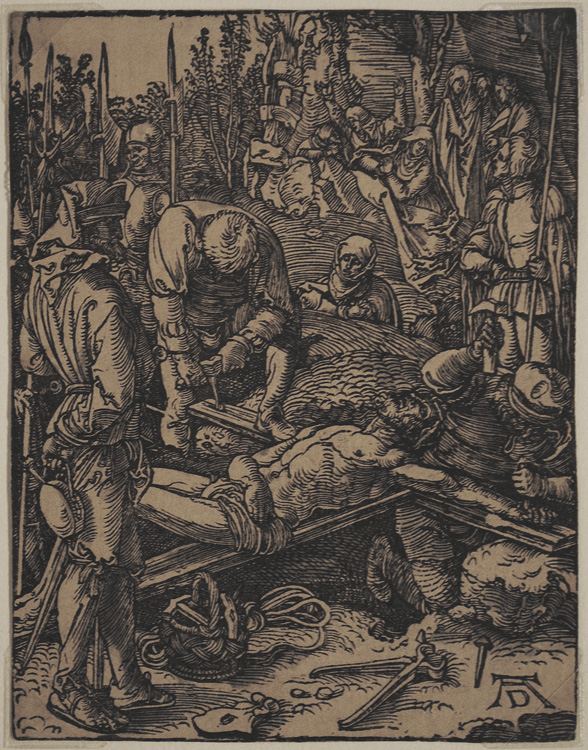 |
|
|
|
|
|
Christ nailed to the Cross (B. 39, S. 123, Meder 148 without text a). Original woodcut, c. 1509. The darkness that occurred from noon to three according to Matthew 28: 47 has begun. The executioner on the right is nailing Jesus' left hand to the cross, the other hand still lies about his waist. Immediately to the rear of Jesus, one of the women appears to be praying, another wrings her hands together, St. John seems to be trying to comfort another, probably Jesus' mother. The image has been trimmed on or within the left border; there are some losses to the top border and on the right border; the bottom border is mostly intact. Overall, this is a very strong impression made very soon after the 1511 Latin first edition. Image size: 126x95mm. Price: Please call or email for current pricing information.
|
|
|
|
|
|
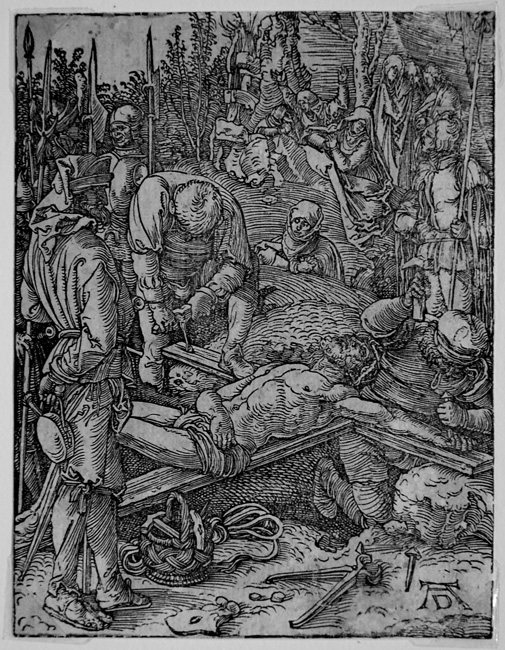 |
|
Christ nailed to the Cross (B. 39, S. 123, Meder 148 without text a). Original woodcut, c. 1509. The darkness that occurred from noon to three according to Matthew 28: 47 has begun. The executioner on the right is nailing Jesus' left hand to the cross, the other hand still lies about his waist. Immediately to the rear of Jesus, one of the women appears to be praying, another wrings her hands together, St. John seems to be trying to comfort another, probably Jesus' mother. The image has been trimmed within the border and top and on the sides; the bottom border is mostly intact except for three small gaps. The lower right corner has a repaired tear. Overall, this is a strong impression made fairly soon after the 1511 Latin first edition. Image size: 126x97mm. Price: Please call or email for current pricing information.
|
|
|
|
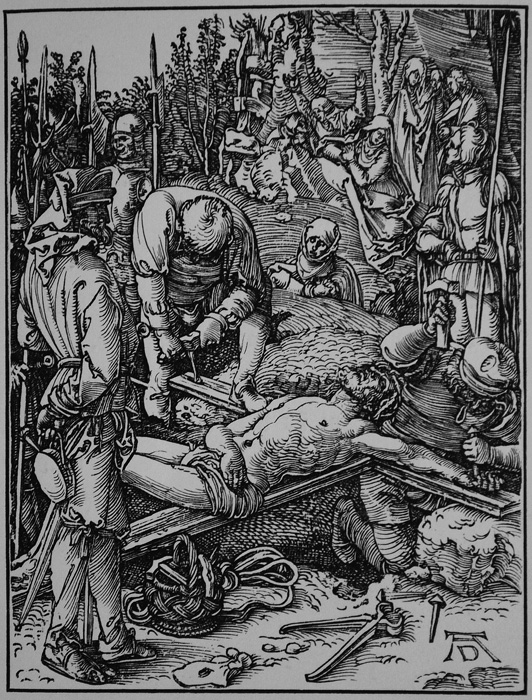 |
|
Christ nailed to the Cross (B. 39, S. 123, Meder 148). Original woodcut, c. 1509. The darkness that occurred from noon to three according to Matthew 28: 47 has begun. The executioner on the right is nailing Jesus' left hand to the cross, the other hand still lies about his waist. Immediately to the rear of Jesus, one of the women appears to be praying, another wrings her hands together, St. John seems to be trying to comfort another, probably Jesus' mother. In 1844 plaster casts were made from Durer's original woodblocks for the Small Woodcut Passion, which had just been acquired by the British Museum. From these casts, metal plates were made and a small edition produced. Our impression is from this edition. Image size: 126x97mm. Price: Please call or email for current pricing information.
|
|
|
|
 |
|
The Crucifixion (B. 40, S. 124) Original woodcut, c. 1509 for the Small Passion. Strauss observes that Dürer "has relegated St. John to a place in the background, behind the group of the Holy Women. He concentrates on the figure of the Magdalen, in the foregound, on her knees, who symboliizes extreme grief in a stance that is imediately comprehensible to the widest possible audience" (Strauss, Woodcuts, p. 378). A good 16th-century impression without text after the first edition with margins outside the border. The block has been chipped in the lower left corner and at the top border at left and center. Some wear, but still printing darkly. Image size: 127x97mm. Price: Please call or email for current pricing information.
|
|
|
|
|
|
|
|
|
|
|
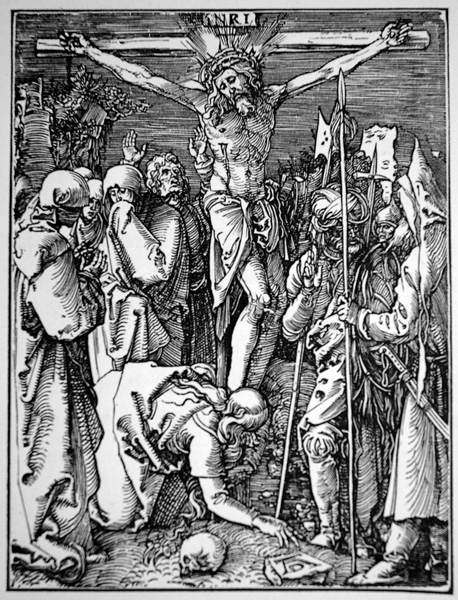 |
|
The Crucifixion (B. 40, S. 124) Original woodcut, c. 1509 for the Small Passion. Strauss observes that Dürer "has relegated St. John to a place in the background, behind the group of the Holy Women. He concentrates on the figure of the Magdalen, in the foregound, on her knees, who symboliizes extreme grief in a stance that is imediately comprehensible to the widest possible audience" (Woodcuts, p. 378). In 1844 plaster casts were made from Durer's original woodblocks for the Small Woodcut Passion, which had just been acquired by the British Museum. From these casts, metal plates were made and a small edition produced. Our impression is from this edition. Image size: 127x98mm. Price: Please call or email for current pricing information.
|
|
|
|
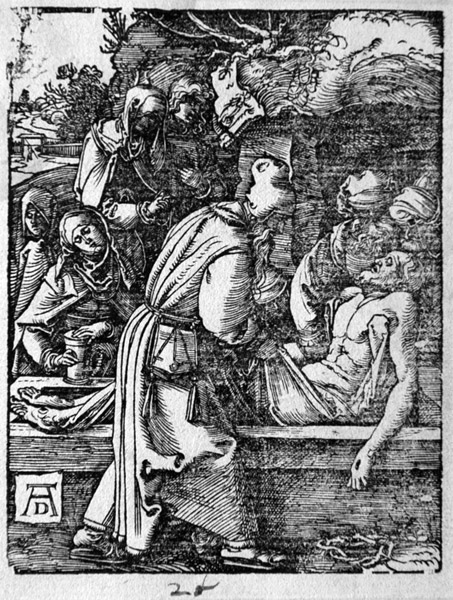 |
|
The Entombment (B. 44, S. 128). Original woodcut, c. 1509-10 for the Small Passion. A fairly good 16th-century impression without text after the first edition with margins outside the border. The block is showing some wear (chipped upper and lower left corners. Image size: 126x97mm. Price: Please call or email for current pricing information.
|
|
|
|
|
|
|
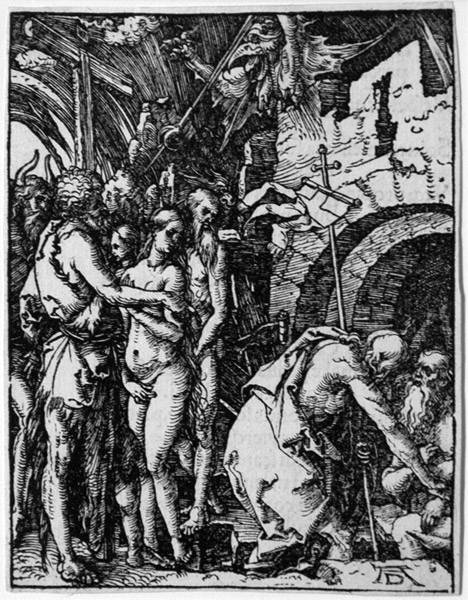 |
|
Christ Harrowing Hell (B. 41, S. 125) Original woodcut, c. 1509 for the Small Passion. A very good impression from the first published edition of 1511, with the Latin text verso. Tiny gap in the border beginning at the lower right corner. A very fine impression with small margins. Image size: 127x97mm. Price: SOLD.
|
|
|
|
|
|
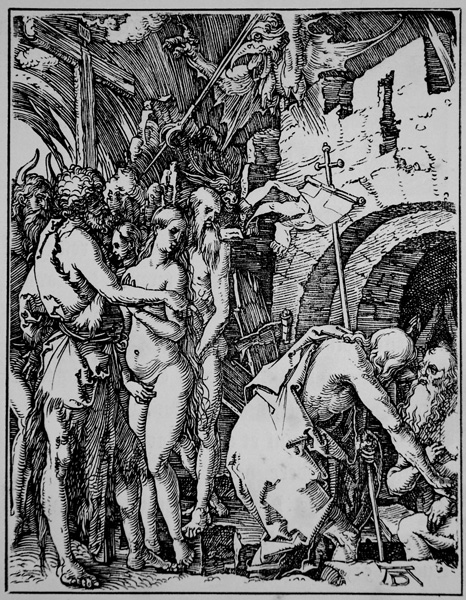 |
|
Christ Harrowing Hell (B. 41, S. 125) Original woodcut, c. 1509 for the Small Passion. In 1844 plaster casts were made from Durer's original woodblocks for the Small Woodcut Passion, which had just been acquired by the British Museum. From these casts, metal plates were made and a small edition produced. Our impression is from this edition. St John the Baptist, Adam, and Eve have already been pulled from the pit; Jeuss is here rescuing one of the patriarchs. Image size: 127x97mm. Price: Please call or email for current pricing information.
|
|
|
|
|
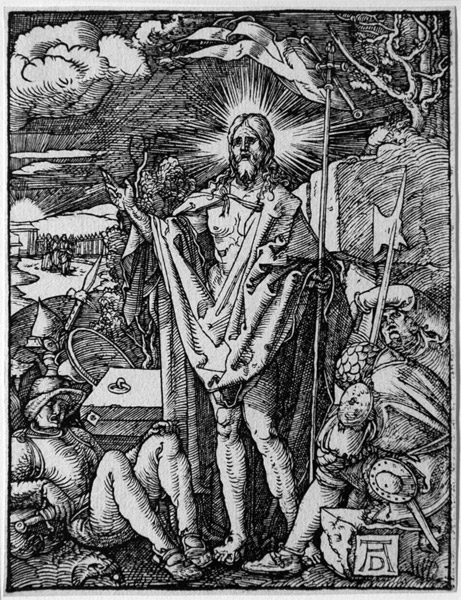 |
|
The Resurrection (B. 45, S. 129). Original woodcut, c. 1510 for the Small Passion. A rich early impression before the first published edition of 1511 (no text on verso). The scene follows Matthew rather than the accounts in the Mark, Luke, or John: "After the sabbath, as the first day of the week was dawning, Mary Magdalene and the other Mary went to see the tomb. And suddenly there was a great earthquake; for an angel of the Lord, descending from heaven, came and rolled back the stone and sat on it. His appearance was like lightning, and his clothing white as snow. For fear of him the guards shook and became like dead men. But the angel said to the women, 'Do not be afraid; I know that you are looking for Jesus who was crucified. He is not here; for he has been raised, as he said. Come, see the place where he lay. Then go quickly and tell his disciples, He has been raised from the dead, and indeed he is going ahead of you to Galilee; there you will see him.’ This is my message for you.' So they left the tomb quickly with fear and great joy, and ran to tell his disciples. Suddenly Jesus met them and said, 'Greetings!' And they came to him, took hold of his feet, and worshiped him. Then Jesus said to them, 'Do not be afraid; go and tell my brothers to go to Galilee; there they will see me.' " The block prints darkly and there are no breaks in the borders. A very fine impression trimmed just outside the borders. Image size: 126x96mm. Price: Please call or email for current pricing information.
|
|
|
|
|
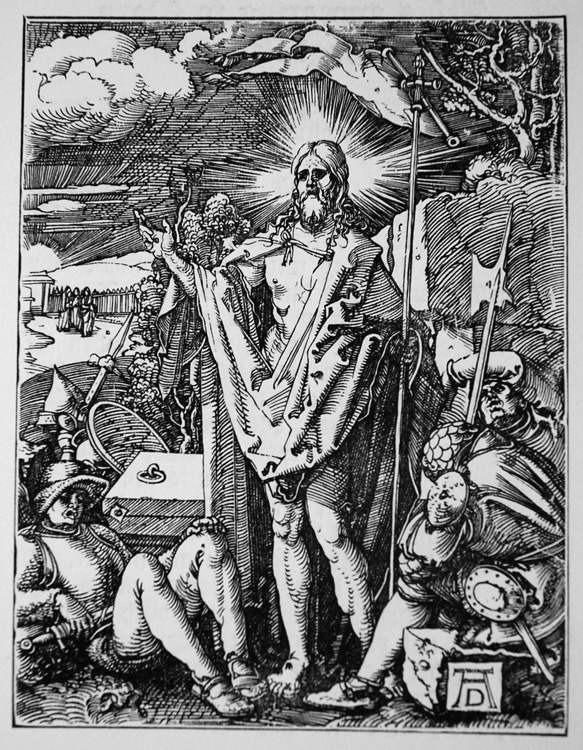 |
|
The Resurrection (B. 45, S. 129) Original woodcut, c. 1510 for the Small Passion. In 1844 plaster casts were made from Durer's original woodblocks for the Small Woodcut Passion, which had just been acquired by the British Museum. From these casts, metal plates were made and a small edition produced. Our impression is from this edition. Image size: 125x95mm. Price: Please call or email for current pricing information.
|
|
|
|
|
|
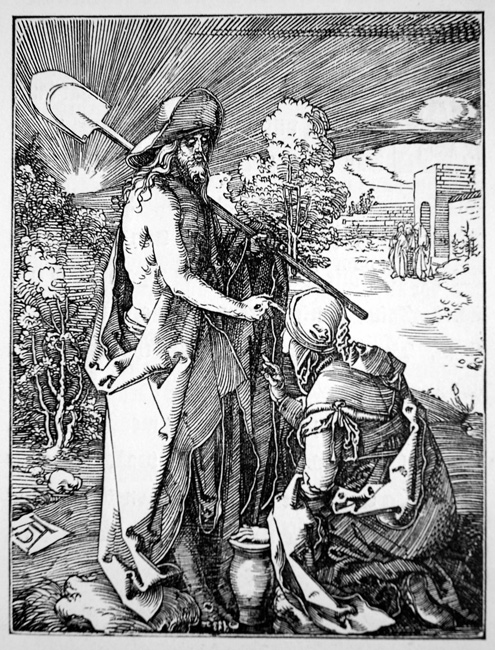 |
|
Noli me tangere / Do not touch me (B. 47, S. 131) Original woodcut, c. 1510 for the Small Passion. Strauss suggests that this woodcut shows Dürer's "genius and inventive powers. He has transformed Christ into a gardener. The broad brim of his hat is turned up to reveal his entire face. The shiny blade of the transfigured Christ's shovel reflects the rising 'sun of righteousness' that already brightens the landscape in the background, and is about to encompass the Magdalen. She is tempted to touch him, who is shown here in an unusual way–partially unclad, with an almost effeminate softness, gently turning her away" (Woodcuts, 392). He also notes that the "minimal cross-hatching is in distinct contrast to the technique of the preceding sheet, in wihch Christ appears to his mother." In 1844 plaster casts were made from Durer's original woodblocks for the Small Woodcut Passion, which had just been acquired by the British Museum. From these casts, metal plates were made and a small edition produced. Our impression is from this edition. Image size: 122x95mm. Price: Please call or email for current pricing information.
|
|
|
|
|
|
|
|
This scene occurs only in John's Gospel (20: 11-18): "But Mary stood weeping outside the tomb. As she wept, she bent over to look into the tomb; and she saw two angels in white, sitting where the body of Jesus had been lying, one at the head and the other at the feet. They said to her, 'Woman, why are you weeping?' She said to them, 'They have taken away my Lord, and I do not know where they have laid him.' When she had said this, she turned around and saw Jesus standing there, but she did not know that it was Jesus. Jesus said to her, 'Woman, why are you weeping? Whom are you looking for?' Supposing him to be the gardener, she said to him, 'Sir, if you have carried him away, tell me where you have laid him, and I will take him away.' Jesus said to her, 'Mary!' She turned and said to him in Hebrew, 'Rabbouni!' (which means Teacher). Jesus said to her, 'Do not hold on to me, because I have not yet ascended to the Father. But go to my brothers and say to them, ‘I am ascending to my Father and your Father, to my God and your God.’ Mary Magdalene went and announced to the disciples, 'I have seen the Lord'; and she told them that he had said these things to her."
|
|
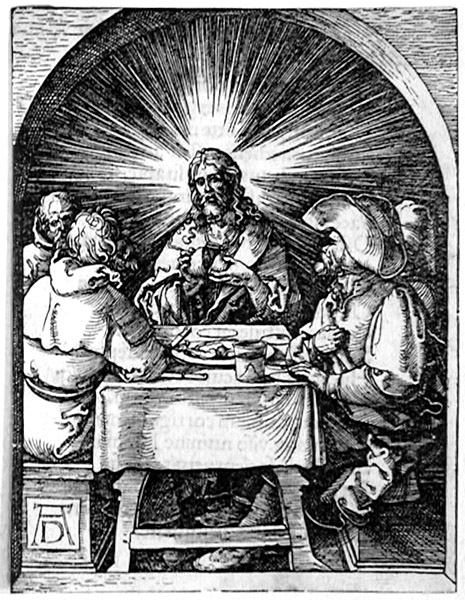 |
|
|
|
|
|
Christ appears to the disciples at Emmaus (B. 48, S. 132, Meder 157) Original woodcut, c. 1510 for the Small Passion. A beautiful impression from the first Latin edition of 1511, with the Latin text and the stamp of Count de Paar on the verso. Strauss observes that Durer has pictured the "exact moment" when the disciples recognize the newly risen Christ. "An instant later Christ would disappear. The plates are still empy, food has not been touched, as the disciple on the left fixes his eyes on Jesus, as if hypnotized. The one oppopsite reaches for his chest in a gesture of amazement." A very powerful and dramatic piece. Several small stains under the table and at the top of the image. Image size: 127x96mm. Price: SOLD.
|
|
|
|
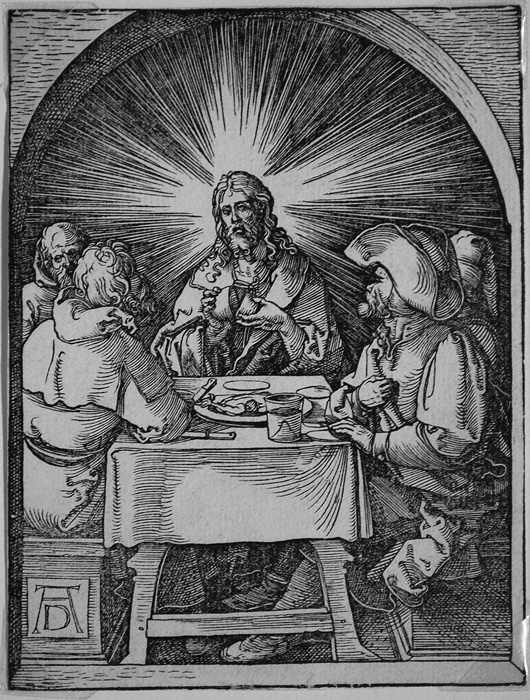 |
|
Christ appears to the disciples at Emmaus (B. 48, S. 132, Meder 157 a/b) Original woodcut, c. 1510 for the Small Passion. A very good impression from soon after the the first Latin edition of 1511, with the stamps of the Kunsthalle Bremmen, the Albertina Graphic Sammlung, and the "Doublett [duplicate] der Albertina" on the verso (see below). The Albertina, in Vienna, has one of the best collections of Dürer in the world, including many from the collection of the Emperor Rudolph II (late 16th-early 17th centuries). Strauss observes that Durer has pictured the "exact moment" when the disciples recognize the newly risen Christ. "An instant later Christ would disappear. The plates are still empy, food has not been touched, as the disciple on the left fixes his eyes on Jesus, as if hypnotized. The one oppopsite reaches for his chest in a gesture of amazement." A very powerful and dramatic piece. Without the Latin text, with 5 very small gaps in the border at top and 5 at the bottom (i.e. more than Meder describes in state a, but less than in state b. Clear, sharp, with no stains or tears. Image size: 127x96mm. Price: Please call or email for current pricing information.
The white areas are lighter than pictured here.
|
|
|
|
|
|
|
 |
|
The stamps of the Kunsthalle Bremmen, the Albertina Graphic Sammlung [collection], and the "Doublett [duplicate] der Albertina" on the verso. The paper, of course, is the same color as in the front side pictured above, but I would have lost the red ink stamp of the Kunsthalle Bremmen had I balanced for the paper. Sorry.
|
|
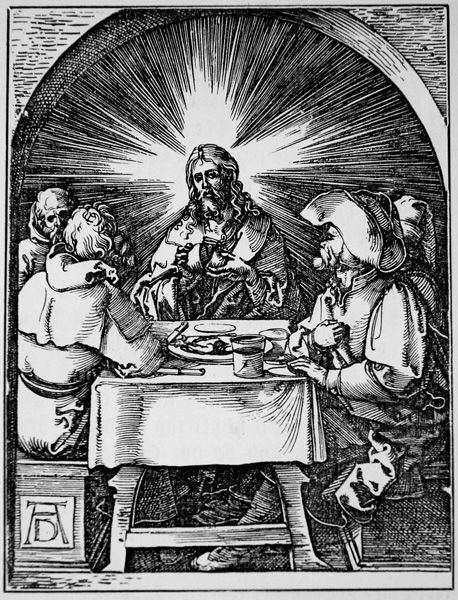 |
|
|
|
|
Christ appears to the disciples at Emmaus (B. 48, S. 132) Original woodcut, c. 1510 for the Small Passion. In 1844 plaster casts were made from Durer's original woodblocks for the Small Woodcut Passion, which had just been acquired by the British Museum. From these casts, metal plates were made and a small edition produced. Our impression is from this edition. Strauss observes that Durer has pictured the "exact moment" when the disciples recognize the newly risen Christ. "An instant later Christ would disappear. The plates are still empy, food has not been touched, as the disciple on the left fixes his eyes on Jesus, as if hypnotized. The one oppopsite reaches for his chest in a gesture of amazement." A very powerful and dramatic piece. Image size: 127x96mm. Price: Please call or email for current pricing information.
|
|
|
|
|
Spaightwood Galleries, Inc.
To purchase, call us at 1-800-809-3343 (1-508-529-2511 in Upton MA & vicinity) or send an email to spaightwood@gmail.com.
We accept AmericanExpress, DiscoverCard, MasterCard, and Visa.
We also accept wire transfers and paypal.
For directions and visiting information, please call. We are, of course, always available over the web and by telephone (see above for contact information). Click the following for links to past shows and artists. For a visual tour of the gallery, please click here. For information about Andy Weiner and Sonja Hansard-Weiner, please click here. For a list of special offers currently available, see Specials.
All works are sold with an unconditional guarantee of authenticity (as described in our website listing).
Go back to the top of this page.
Visiting hours: Saturday 10:00 am to 5:00 pm and Sunday noon to 6:00 pm and other times by arrangement.
Please call to confirm your visit. Browsers and guests are welcome.
|
|
|
|
|
|
|
|
|
|
|
|
|
|
|
|
|
|
|
|
|
|
|
|
|
|
|
|
|
|
|
|
|
|
|
|
|
|
|
|
|
|
|
|














